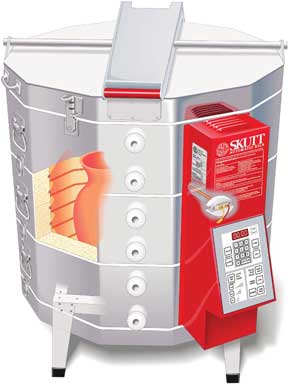 Understanding how yow kiln is constructed can be very helpful in troubleshooting problems and maintaining it properly. There are many types of kilns however for the purpose of this site we are only going to discuss the most common kilns used in the home; top loading electric kilns with automatic controllers.
Understanding how yow kiln is constructed can be very helpful in troubleshooting problems and maintaining it properly. There are many types of kilns however for the purpose of this site we are only going to discuss the most common kilns used in the home; top loading electric kilns with automatic controllers.
The Brick
Kiln brick is made of refractory (high temperature) ceramic material that is designed to withstand temperatures up to 2350 F. It is formed by mixing the crushed material with wood pulp and then firing it to burn out the pulp, leaving tiny pockets of air. This makes the brick very light and, because air is the best insulator, able to contain the heat in the kiln. It is then precisely machined for the various shapes needed.
The lid and bottom of the kiln are constructed by using a high temperature mortar to attach the brick together and then cut to shape. The sidewalls are generally not mortared, but held together by compressing them with a stainless steel band. The bricks used in the construction have grooves machined into them to hold the elements. Top-fired glass kilns have these grooves cut into the lid and the elements are pinned in place.
The Bands
The bands that hold the brick together are generally made of stainless steel so they will resist corrosion. They are attached around the brick with worm screws so they can be tightened periodically to keep the brick from getting loose and shifting. It is important to keep the bands clean and dry. Even though they are made of stainless steel they will corrode if exposed to moisture and corrosive materials like salt and sulfur.
Peep Plugs
Peep plugs were originally developed to plug the holes in the kiln that were used to “peep” into the kiln. A pyrometric cone was placed on one or more shelves in the kiln while it was firing. The kiln owner would pull the plug out when they thought the kiln was nearing the end of the firing and look to see if the cone had bent. When the cone bent to the right position, it signaled that the ware had received the proper amount of heatwork and the operator would manually shut down the kiln.
Now that kilns have automatic controllers the peep plugs are used mostly to vent the kiln. They are pulled out to let fumes escape or to allow the kiln to cool faster.
Hardware
Hardware is everything attached to the bands of your kiln except the controller. This includes the hinge, lid brace, handles, latches, and lid lifters. Most of these components are made of corrosion resistant metal or ceramic. It is extremely important to make sure these items are tightened occasionally. The lid brace is especially important on larger kilns because it supports the lid above your head while loading the kiln.
Thermocouple
The thermocouple is the temperature-sensing device that extends into the kiln chamber and tells the controller what the temperature is so it knows when to turn on and off power to the kiln. Most hobby kilns use “Type K” thermocouples. They are fairly inexpensive to replace and can last relatively long, however they will eventually need to be replaced. Thermocouples will start drifting to an over fire when they need to be replaced, meaning the kiln will fire hotter than it should. This is generally a gradual process so you should have plenty of warning before you damage any ware. They are very easy to replace so you should be able to do this without the help of a professional.
Controllers
Finally to the brains of the kiln, the controller. Automatic controllers have been around in the hobby industry since the early 1990’s. They replaced KilnSitter controllers that were mechanical devices that utilized a pyrometric cone to shut off the kiln. Automatic controllers allow you to do things that you cannot do well with mechanical controls; accurately control firing rates and holds, hold at peak temperature and control the cooling rate.
The power comes into the control box through the power cord where it is distributed to the relays and the controller. Since the controller runs on low voltage the power to the controller must first pass through a transformer to change the voltage from 120V or 240 Volts to 24 volts.
The thermocouple is connected to the controller and tells it what the temperature is in the kiln chamber. The controller then takes this information to determine whether the relays should send power to the elements. Pyrometric cones are used to verify the accuracy of your thermocouple.



